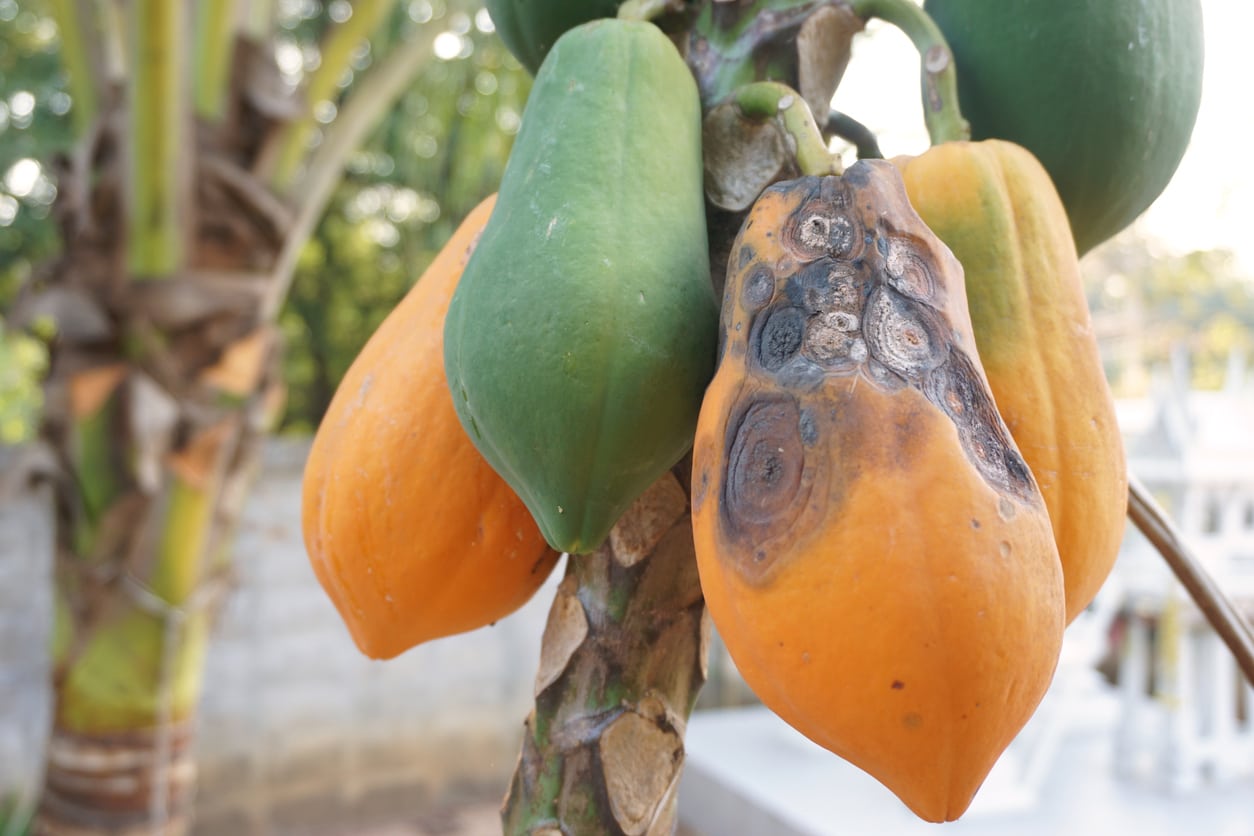Anthracnose Of Papaya Trees: Learn About Papaya Anthracnose Control


Papaya (Carica papaya) is an attractive tree grown for its tropical look and delicious, edible fruit, large green berries that ripen to yellow or orange. Some people call the tree and the fruit pawpaw. When you see sunken spots on those papaya fruit, you may be dealing with anthracnose of papaya trees. But with some cultural practices, papaya anthracnose control in the home orchard isn’t difficult. Read on for tips on treating papaya anthracnose.
What is Papaya Anthracnose?
Papaya anthracnose is a serious fungal disease caused by the pathogen Colletotrichum gloeosporioides. The spores of this disease are spread in rainy, humid periods, by rain, splash back, plant to plant contact and unsanitized tools. Spore growth and spread is most common when temperatures are between 64-77 F. (18-25 C.). Spores infect the plant tissues then go dormant until around harvest time.
Anthracnose of Papaya Trees
Gardeners who live in Hawaii or other tropical to subtropical regions often grow tropical fruits, such as papaya. In fact, in Hawaii, papaya fruits are grown commercially as a major food and export crop, bringing in approximately $9.7 million each year. However, papaya anthracnose is a serious disease of papaya fruits that can lead to devastating crop losses each year. Your orchard may not be in the tropics, so you're more likely to get anthracnose on papaya in certain types of weather. Environmental conditions favoring the fungus include very high temperatures plus high humidity. In these conditions, papaya anthracnose control is difficult. But humidity must be truly high to affect the papayas. The fungal spores causing anthracnose don’t usually germinate when your area has less than 97 percent relative humidity. They also need lots of rain. In fact, rain drops splashing on tree leaves is among the ways anthracnose of papaya trees spreads. The fungus doesn’t spread much at all when the weather is dry.
Identifying Anthracnose on Papaya
You can tell if you have papayas with anthracnose by keeping a close eye on the fruit as it ripens. Papaya fruit start out hard with smooth green skins. As they mature, however, the skin turns golden and the flesh softens. That’s when the anthracnose can appear. If your tree has developed the disease anthracnose, you may see small tan to gray spots on papaya fruit or foliage. As these spots grow, they become larger sunken lesions with a water-soaked appearance. These spots are the initial symptoms of anthracnose of papaya trees. You’ll see the centers of the spots blacken over time. As the fungus produces spores, the black spots turn pink and the fruit beneath gets extremely soft. The disease can be present on harvested fruit, but not appear until fruits are stored or shipped. In tropical or subtropical regions with high humidity and annual rains, papaya anthracnose can also cause crop loss of banana, mango, avocado, passion fruit and coffee.
Treating Papaya Anthracnose
Monitoring the ripe fruit for spots will help you identify anthracnose on papaya early. That means you can start treating papaya anthracnose early too. Once the disease is present, proper sanitation is essential. Early action means that you can probably avoid using chemicals when treating papaya anthracnose. Use cultural control measures like harvesting mature fruit promptly, instead of leaving it on the tree. You should also remove all dead leaves and fruit from the garden. Take special care to get all those fallen under and around the papaya tree. Cleaning up weeds or other garden debris can prevent the spread of papaya anthracnose from rain splash back and plant-to-plant contact. Also, always sanitize tools to prevent the spread of diseases. Before papaya flowers appear or just as they appear, preventative fungicides may help control papaya anthracnose. Use a fungicide containing Copper hydroxide, Mancozeb, Azoxystrobin or Bacillus. Spray the orchard with the fungicide every two to four weeks. You can also try growing resistant varieties such as Kapoho, Kamiya, Sunrise or Sunset to prevent the disease.
Sign up for the Gardening Know How newsletter today and receive a free copy of our e-book "How to Grow Delicious Tomatoes".

Teo Spengler is a master gardener and a docent at the San Francisco Botanical Garden, where she hosts public tours. She has studied horticulture and written about nature, trees, plants, and gardening for more than two decades, following a career as an attorney and legal writer. Her extended family includes some 30 houseplants and hundreds of outdoor plants, including 250 trees, which are her main passion. Spengler currently splits her life between San Francisco and the French Basque Country, though she was raised in Alaska, giving her experience of gardening in a range of climates.